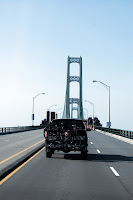Normally I would limit the content of this blog as much as possible to matters of public history. On occasion I do want to share with you some concerns that arise in my "day job" over at http://www.militaryvetshop.com/. Historians communicate to the public through writing, documentaries, websites, and museum displays. Therefore, issues of copyright and trademark do come up on occasion, so I think you will find the following information interesting:
The availability of t-shirts and coffee mugs with any reference to the United States Marine Corps (USMC) might be seriously curtailed. Recently the USMC, from their newly created Trademark Licensing Office, has claimed trademark rights on all emblems and terms that might reference the Corps. This includes the word “Marine” and any reference to Marine Veterans. The claim also encompasses terms like “USMC,” and even “Semper Fi.”
Each of the military services has always protected the use of the service seals representing the Department of the Army, the Department of the Navy, etc. This is allowed in Federal Statutes and it is understandable to prevent an organization from inferring that they officially represent one of the branches of the military. However, there has never been any claim to copyright or trademark of terms against those designs that represent the military in a positive light and with respect to veterans. Civilian companies have always created products that celebrate the service of veterans without the requirement of licensing. With the advent of print-on-demand (POD) technology and Internet sales, these designs and products have multiplied to unimaginable numbers. It would easily be assumed that terminology that refers to the military branches, or emblems created by these government organizations would be in the public domain and free to use by anyone. Apparently, that is not true anymore.
In December of 2007, the Department of Defense (DOD) initiated a directive for each service to “establish a branding and trademark licensing office to manage and coordinate a DOD-wide brand development and trademark licensing program.” You can read that Directive here: http://www.dtic.mil/whs/directives/corres/pdf/553509p.pdf. The other services have exercised restraint in the application of this directive. For example, the Department of the Army enforces trademark on the Department of the Army seal and any copyright enforcement on shoulder sleeve insignia is delegated to the unit commander. The Air Force, so far, has chosen to only enforce their trademark on their seal, and the “high wings” emblem that you see on recruiting commercials.
The Marine Corps, however, has really taken the ball and run with it. They established their trademark office in July of 2009. Currently they are contacting print-on-demand companies and requesting that ANY design that refers to the USMC in ANY WAY, be removed from the site until a usage license is obtained from the Marine Corps. The Marine Corps was contacted directly and a representative stated that no licenses had been issued yet. Nevertheless, they were serious about enforcing what they saw as their trademark rights. When a license is issued, it will cost $1,000 to apply and a minimum of $5,000 per year in royalties. This figure puts most of us little guys out of business. For example, Military Vet Shop only earns a couple of hundred dollars per year on USMC veteran items, despite our loyal customers who wear our designs with pride.
Military Vet Shop uses two POD providers, Cafepress and Zazzle. We post on two different sites so that we can offer our customers a larger number of products and styles from which to choose. Currently, Zazzle is systematically searching their product database for any USMC designs and deleting them, with only an email notification to the designer that the removal was at the request of the Marine Corps. With no communication coming from Zazzle, the information in this article was gathered from other websites and the Zazzle seller forums. Within a few days we will no longer be able to offer any USMC veteran items on Zazzle.
So far, no action has been taken by Cafepress. We assume, and hope, that they are negotiating a collective license agreement for all designers who post their work on the Cafepress website. This is the option that we wish Zazzle had chosen, rather than becoming intimidated by the issue.
The USMC is perfectly within their rights to enforce a trademark that is specifically laid out in a federal law that allows them to do so. Even if the license fees go into the USMC Morale and Welfare Fund, we are still very disappointed in the direction the Marine Corps has decided to take. We think the morale of the veterans we honor is important too. It saddens us to see the “corporatization” of any of our military services.
If you would like to read more about this issue, here are some links for you:
Marine Corps Trademark Office, FAQs: http://www.marines.mil/unit/divpa/tmlo/Pages/faq.aspx
Federal Statute authorizing trademark of terms: http://law.justia.com/us/cfr/title32/32-5.1.1.7.33.0.37.6.html
A simple (and short) explanation of trademark and copyright: http://www.lawmart.com/forms/difference.htm























